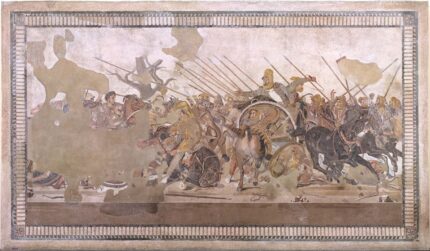 The iconic mosaic of Alexander the Great’s victory over the Persian forces of Darius III at the Battle of Issus will be restored in public view at the National Archaeological Museum of Naples (MANN). The project begins at the end of the month and will continue until July. A mutlidisciplinary team of experts will use the latest technology to study, clean and conserve the massive masterpiece.
The iconic mosaic of Alexander the Great’s victory over the Persian forces of Darius III at the Battle of Issus will be restored in public view at the National Archaeological Museum of Naples (MANN). The project begins at the end of the month and will continue until July. A mutlidisciplinary team of experts will use the latest technology to study, clean and conserve the massive masterpiece.
The Alexander Mosaic is believed to be a copy of a Greek painting by Philoxenus of Eretria from the Hellenistic era (late 4th, early 3rd century B.C.). Pliny praised the work in his Natural History: “Philoxenus of Eretria, who painted for King Cassander a picture representing one of the battles between Alexander and Darius, a work which may bear comparison with any.” (Cassander was king of Macedon from 317 to 297 B.C., which narrows down the date of the painting.)
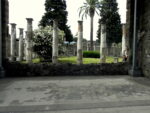 The mosaic was discovered in the floor of the exedra (an open-air sitting area) in the House of the Faun in Pompeii in 1832. It was made around 120-100 B.C. and is of unparalleled quality and size, a testament to the great wealth of the owners of the House of the Faun which is the largest and most elaborately decorated villa in the city. The villa occupied an entire insula (city block) and covered a whopping 32,000 square feet on two floors. The Alexander mosaic was a focal point of a dramatic visual axis down the length of the house, from the HAVE (“welcome”) mosaic on the threshold, through the 52-foot length of the atrium, the triclinium (dining room) and a small peristyle to the exedra that opened to the villa’s grand peristyle.
The mosaic was discovered in the floor of the exedra (an open-air sitting area) in the House of the Faun in Pompeii in 1832. It was made around 120-100 B.C. and is of unparalleled quality and size, a testament to the great wealth of the owners of the House of the Faun which is the largest and most elaborately decorated villa in the city. The villa occupied an entire insula (city block) and covered a whopping 32,000 square feet on two floors. The Alexander mosaic was a focal point of a dramatic visual axis down the length of the house, from the HAVE (“welcome”) mosaic on the threshold, through the 52-foot length of the atrium, the triclinium (dining room) and a small peristyle to the exedra that opened to the villa’s grand peristyle.
An estimated 1.5 million tesserae in four colors (white, yellow, red, blue/black) were arranged in fine opus vermiculatum style (meaning wormlike, for its tiny segments arranged in undulating asymmetrical lines) that used color gradations to create an incredibly detailed, smooth, realistic 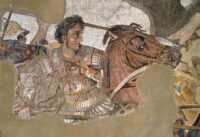 effect. It measures almost 9-by-17 feet and is 215 square feet in area. There are more than 50 people in the melee, with Alexander and Darius facing off above their armies. Alexander is astride his steed Bucephalus, leading the Macedonian cavalry; Darius stands in his chariot, his horses dynamically facing the viewer as they turn around in retreat.
effect. It measures almost 9-by-17 feet and is 215 square feet in area. There are more than 50 people in the melee, with Alexander and Darius facing off above their armies. Alexander is astride his steed Bucephalus, leading the Macedonian cavalry; Darius stands in his chariot, his horses dynamically facing the viewer as they turn around in retreat.
In 1844, the whole mosaic was raised from the floor and transported by oxcart to what was then Naples’ Royal Bourbon Museum. They installed it in the floor where people, you know, walked on it, so in 1916 it was reinstalled on the wall where it has been on display ever since. It is a world-famous symbol of the museum, of Pompeii and one of the most-recognized images of Alexander the Great.
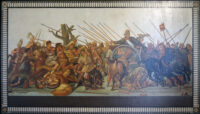 The Battle of Issus weighs seven tons and known issues include detaching tiles, damaged tiles, vertical and horizontal microfractures, and shifts in the underlay. Previous investigations have found that much of the deterioration in the mosaic may be due to the oxidation of the iron reinforcements and degradation of the mortar used to affix the tesserae to the background. It’s heavy weight and vertical placement put it in a constant battle with gravity as well.
The Battle of Issus weighs seven tons and known issues include detaching tiles, damaged tiles, vertical and horizontal microfractures, and shifts in the underlay. Previous investigations have found that much of the deterioration in the mosaic may be due to the oxidation of the iron reinforcements and degradation of the mortar used to affix the tesserae to the background. It’s heavy weight and vertical placement put it in a constant battle with gravity as well.
The first step in the conservation process will to consolidate loose layers or mortar and tiles, doing a light cleaning of the surface and bandaging all the surface. The mosaic will then be removed with a mechanical lifting system custom-designed for this job. The entire mosaic will then be examined and analyzed to confirm the next actions to take. Between April and July, the support will be stabilized while the face of the mosaic, protected by planking, will be projected onto a wall so conservators can see which area of the mosaic they are treating and the public can see them at work. The last step will be the removal of the bandages and planking, cleaning, any final consolidations and a new protective treatment.
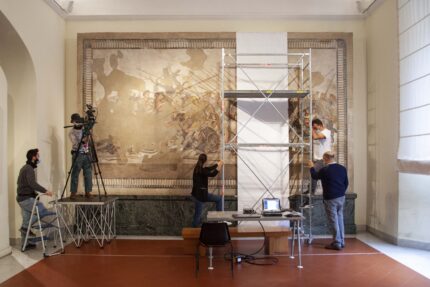
What I was completely unaware of is the etymology of the name ‘Alexander‘:
Firstly, ‘Alexema’/ἀλέξημα means ‘defence, guard, help’, while ‘Andros’/ἁνδρός means the genetive of ‘man’. So to speak, he is the defender of mankind, or at least of those parts of the world that just a few years earlier almost had been utterly conquered by the mentioned Persians.
The man himself might have had a (non-greek) Macedonian name, but on that I have no information whatsoever. There is a Mycenaean Greek feminine anthroponym 𐀀𐀩𐀏𐀭𐀅𐀨, a-re-ka-sa-da-ra (Alexandra), and in ca. 1280 BC a king of Wilusa (a.k.a. “Troy”) by the name of Alaksandu, (Hittite: 𒀀𒆷𒀝𒊭𒀭𒁺𒍑 Alâkšândûš).
Contrastingly, in the Middle East, our man is referred to as ‘Iskander’ (also the 29528th most common surname in the US of A, according to the 2010 United States Census). The Arabic version, however, adds the definite-article prefix al-, giving ‘al-Iskandar’ (الاسكندر).
Highly suspicous are the terms for ‘defense’ in Hindi रक्षा (rakṣā) and in Sinhalese: ආරක්ෂක (ārakṣaka), even if our man seemingly stopped his Indian ambitions already in the Ganges Plain in 325 BC.
:hattip:
What an amazing work of art. The details involved in the minute tile work. It is a shame that no one will ever know who the artist was.
You dont get covid from painting bitch
Alexander, as the rest of the Macedonians, were greeks of Doric origins, living in the outskirts of the greek world. They evolved with different traditions and institutions, similar to the Homeric world. They bear greek names, as we know from 5th cent. BC grave stones discovered in macedonian sites. In fact, the royal family of Macedon was also related with the city of Argos in the Peloponnese, which is why they are also called Argeads.
Dear Mr. Tomas, Do you make any difference between helenic and helenistic? Proving that Alexandar and the Macedonians were only greek and nothing else destroys big part of the anciant history. Alexandar belongs to the whole world, because his vision was much larger than the Macedonian empire… :yes:
Great leader.